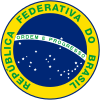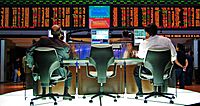Brazil facts for kids
Quick facts for kids
Federative Republic of Brazil
República Federativa do Brasil
|
|
|---|---|
|
Motto:
Ordem e Progresso "Order and Progress" |
|
|
Anthem:
Hino Nacional Brasileiro "Brazilian National Anthem" Flag anthem:
Hino à Bandeira Nacional "National Flag Anthem" |
|
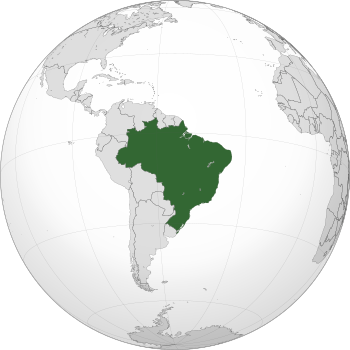 |
|
| Capital | Brasília 15°47′S 47°52′W / 15.783°S 47.867°W |
| Largest city | São Paulo 23°33′S 46°38′W / 23.550°S 46.633°W |
| Official language and national language |
Portuguese |
| Recognized regional languages | See regional official languages |
| Ethnic groups
(2022)
|
|
| Religion
(2022)
|
|
| Demonym(s) | Brazilian |
| Government | Federal presidential republic |
| Lula da Silva | |
| Geraldo Alckmin | |
| Arthur Lira | |
| Legislature | National Congress |
| Federal Senate | |
| Chamber of Deputies | |
| Independence
from Portugal
|
|
|
• Declared
|
7 September 1822 |
|
• Recognized
|
29 August 1825 |
|
• Republic
|
15 November 1889 |
|
• Current constitution
|
5 October 1988 |
| Area | |
|
• Total
|
8,515,767 km2 (3,287,956 sq mi) (5th) |
|
• Water (%)
|
0.65 |
| Population | |
|
• 2022 census
|
|
|
• Density
|
23.8/km2 (61.6/sq mi) (193rd) |
| GDP (PPP) | 2024 estimate |
|
• Total
|
|
|
• Per capita
|
|
| GDP (nominal) | 2024 estimate |
|
• Total
|
|
|
• Per capita
|
|
| Gini (2022) | ▼ 52 high |
| HDI (2022) | high · 89th |
| Currency | Real (R$) (BRL) |
| Time zone | UTC−2 to −5 (BRT) |
| DST is not observed. | |
| Date format | dd/mm/yyyy (CE) |
| Driving side | right |
| Calling code | +55 |
| ISO 3166 code | BR |
| Internet TLD | .br |
Brazil (officially called Federative Republic of Brazil) is a large country in South America. It is the world's fifth largest country by land area. Brazil has about 203 million people. The capital of Brazil is Brasília.
Contents
Brazil's Past: A Journey Through Time
The first people arrived in Brazil around 9,000 B.C. These groups were often called South American Indians. They likely came from North America. Some were hunters and gatherers, while others were farmers.
European Arrival and Independence
Pedro Álvares Cabral was the first European to reach Brazil in 1500. He was from Portugal, and the Portuguese government claimed Brazil. Soon, explorers mapped the coastline, and colonies were set up. In the late 1500s and early 1600s, the Dutch and French sometimes tried to take land. Brazilians began moving further inland than allowed by the Treaty of Tordesillas. This led to conflicts with Spanish settlers and native people.
In 1822, Brazil declared itself an independent country, no longer part of Portugal. A civil war followed. Emperor Pedro II later improved the economy. In 1888, he freed all enslaved people. In 1889, a military coup forced Pedro II to leave the country.
From Republic to Modern Democracy
Brazil became a republic in 1889. It was not very democratic at first, as only landowners could vote. In the 1920s, some uprisings occurred. People felt the government unfairly favored coffee growers. Brazil later joined the Allies during World War II.
In the 1960s, leader Castelo Branco made the government more like a dictatorship. Since then, Brazil has become more democratic. However, some people still believe there are major issues in health and education. In September 2016, then-president Dilma Rousseff was removed from office through impeachment.
Languages Spoken in Brazil
Most people in Brazil speak Portuguese. Brazil is the only country in Latin America where Portuguese is the main language.
Some Brazilians speak German dialects. These came from German immigrants. About 0.8% of Brazilians speak German as their first language.
Other languages spoken include indigenous Brazilian languages, Italian, Japanese, French, and Spanish. A small number of Brazilians speak Guaraní and Aymará.
Brazil's Amazing Geography
Brazil covers a huge area along South America's eastern coast. It includes much of the continent's inner land. Brazil shares land borders with almost every South American country. Only Ecuador and Chile do not border Brazil.
Brazil also includes several islands in the Atlantic Ocean. These include Fernando de Noronha and Trindade and Martin Vaz. Brazil is the fifth largest country in the world. It is the third largest in the Americas. Its total area is about 8,515,767 square kilometers.
Climate Zones Across Brazil
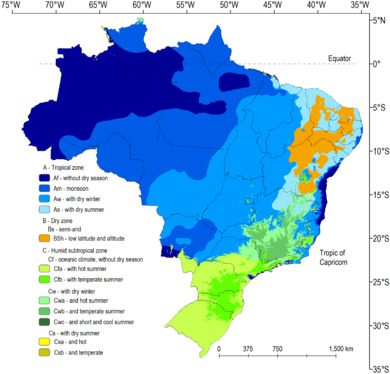
Brazil has many different weather conditions. Most of the country has a tropical climate. Brazil has six main climate types. These include desert, equatorial, tropical, semiarid, oceanic, and subtropical. These climates create diverse environments. You can find rainforests in the north. There are semiarid deserts in the northeast. Tropical savannas are in central Brazil.
Northern Brazil has an equatorial climate. There is no true dry season. Temperatures average around 25°C. Daily temperature changes are greater than seasonal ones.
Central Brazil has more seasonal rainfall. This is typical of a savanna climate. The interior northeast has even more extreme seasonal rain. This semiarid region gets less than 800 mm of rain. Most rain falls in three to five months. Long droughts can happen. A severe drought in 1877–78 caused many deaths.
South of Bahia, near the coasts, rain falls all year. The south has subtropical conditions. Winters are cool, and average yearly temperatures are below 18°C. Frost and snowfall can occur in higher areas.
Rich Biodiversity and Environment
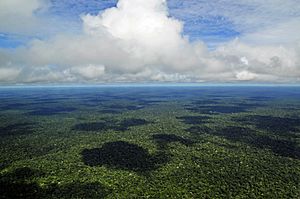
Brazil's large area has many different ecosystems. The Amazon rainforest has the most biological diversity in the world. The Atlantic Forest and Cerrado also have great biodiversity. In the south, Araucaria pine forests grow.
Brazil's rich wildlife shows its varied natural habitats. Scientists think Brazil has up to four million plant and animal species. Most of these are invertebrates. Larger mammals include pumas, jaguars, and ocelots. There are also tapirs, anteaters, and armadillos. Many types of New World monkeys live in the northern rainforests.
Environmental concerns have grown globally. Brazil's Amazon Basin has many fish species. This includes the red-bellied piranha. Despite its fierce reputation, it is usually a shy scavenger.
Brazil's natural heritage faces threats. These include cattle ranching, logging, and mining. Dams and pollution also cause problems. Many areas are threatened by new developments. Highways open up remote areas. Dams flood valleys and animal homes. Mines scar and pollute the land. Over 70 dams are planned for the Amazon region.
How Brazil is Governed
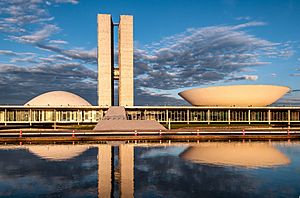
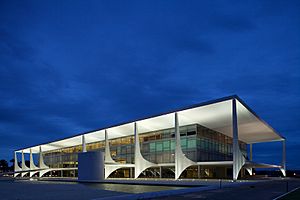
Brazil has a democratic federative republic. It uses a presidential system. The president leads both the country and the government. They are elected for a four-year term. They can be re-elected once. The president chooses the ministers who help run the government.
Laws are mainly made by legislative bodies. The National Congress has two parts. These are the Chamber of Deputies and the Federal Senate. Courts handle legal duties. In 2021, Brazil was called a "flawed democracy". It was also seen as a free country.
Brazil's government has different levels. These are the Union (federal), states, Federal District, and municipalities. These are the "spheres of government." The country is based on five main ideas. These are sovereignty, citizenship, human dignity, social value of work, and political pluralism.
The government has three main branches: executive, legislative, and judicial. They work independently. The executive and legislative branches are elected. The judicial branch is at federal and state levels.
Brazil has many political parties. Voting is required for literate people aged 18 to 70. It is optional for others. Brazil has over 40 active political parties. It is common for politicians to change parties.
Brazil's Economy and Tourism
Brazil has the largest economy in Latin America. It is the world's ninth largest economy. Brazil has a mixed economy with many natural resources.
The country is growing in international markets. It is part of the BRIC countries. Brazil has been the world's largest coffee producer for 150 years. It exports many products. These include soy, iron ore, pulp, maize, beef, and chicken. Other exports are sugar, coffee, tobacco, and airplanes.
Exploring Brazil: Tourism
Tourism in Brazil is growing. It is important for many regions. In 2018, Brazil was the 48th most visited country. It welcomed 6.6 million tourists.
Natural areas are very popular. People enjoy ecotourism, beaches, and adventure travel. Cultural tourism is also popular. Top destinations include the Amazon rainforest. Beaches and dunes in the Northeast are also popular. The Pantanal in the Center-West is another highlight. Rio de Janeiro and Santa Catarina have great beaches. Minas Gerais offers cultural sites. São Paulo is popular for business trips.
Brazilian Culture: A Rich Mix
Brazil's main culture comes from Portuguese culture. This is because Portugal colonized Brazil for a long time. The Portuguese brought their language and Roman Catholicism. They also brought their architectural styles.
Other cultures also strongly influenced Brazil. These include African, indigenous, and other European cultures. Italian, German, Japanese, Jewish, and Arab immigrants also added to the culture. They arrived in large numbers in the 19th and 20th centuries. Indigenous people influenced Brazil's language and cuisine. Africans influenced language, food, music, dance, and religion.
Brazilian art has changed over centuries. It includes styles like Baroque and Modernism. Brazilian cinema started in the late 1800s. It has gained international fame since the 1960s.
Architecture: From Colonial to Modern
Brazilian architecture is influenced by Europe, especially Portugal. Its history goes back 500 years. Portuguese colonial architecture was the first style in Brazil. It formed the base for later styles. In the 19th century, Brazil adopted Neoclassical and Gothic Revival architecture. In the 20th century, Brazil experimented with Modernist architecture, especially in Brasília.
Colonial architecture began in the early 16th century. The Portuguese built churches, houses, and forts. They used styles familiar to them in Europe.
In the 19th century, more European styles arrived. These included Neoclassical and Gothic Revival. They often mixed with Brazilian influences. This created a unique Brazilian architectural style.
In the 1950s, modernist architecture became popular. This happened when Brasília was built as the new capital. Architect Oscar Niemeyer designed many government buildings and churches in this style.
Music: Rhythms of Brazil
Brazilian music comes from European, Native Indigenous, and African elements. Portugal was the main source of influences until the 1800s. The first important composer was José Maurício Nunes Garcia. He wrote sacred music influenced by Viennese classicism. African elements brought rhythmic diversity. They also brought dances and instruments. These became very important in popular and folk music in the 20th century.
Popular music started to sound uniquely Brazilian in the late 1700s. Samba is considered the most typical style. It is on the UNESCO cultural heritage list. Maracatu and Afoxê are two music traditions. They are popular at the annual Brazilian Carnivals. Capoeira is usually played with its own music. This is a call-and-response folk music style. Forró is a folk music type. It is popular during the Festa Junina in northeastern Brazil.
Choro is a popular instrumental style. It started in 19th-century Rio de Janeiro. Despite its name, it often has a fast, happy rhythm. It is known for its skill, improvisation, and complex melodies. Bossa nova is another well-known style. It was developed in the 1950s and 1960s. "Bossa nova" means "new trend." It mixes samba and jazz. Bossa nova became very popular in the 1960s.
Literature: Stories and Poems

Brazilian literature began in the 16th century. The first Portuguese explorers wrote about Brazil. Pêro Vaz de Caminha described the fauna, flora, and indigenous people. These writings fascinated European readers.
Brazil produced important works in Romanticism. Novelists like Joaquim Manuel de Macedo wrote about love and pain. José de Alencar wrote about indigenous people as heroes. His novels include O Guaraní and Iracema. Machado de Assis, a contemporary, wrote in many styles. He is still highly respected by critics worldwide.
Brazilian Modernism began in 1922. It focused on a nationalist, avant-garde literature. Post-Modernism brought new poets. These include João Cabral de Melo Neto and Carlos Drummond de Andrade. Famous writers like Jorge Amado and Clarice Lispector wrote about universal and regional topics.
Brazil shares the Camões Prize with other Portuguese-speaking countries. Brazil also has its own literary academy. The Brazilian Academy of Letters protects the national language and literature.
Cuisine: A Taste of Brazil
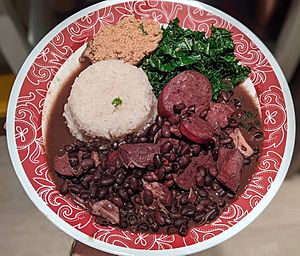
Brazilian food varies greatly by region. This shows the mix of indigenous and immigrant groups. This has created a national cuisine with strong regional differences. Feijoada is considered the country's national dish. Other regional foods include beiju, feijão tropeiro, and moqueca. Polenta comes from Italian cuisine. Acarajé comes from African cuisine.
The national drink is coffee. Cachaça is Brazil's native liquor. It is made from sugar cane. Cachaça is the main ingredient in the national cocktail, Caipirinha.
A typical Brazilian meal includes rice and beans. It often has beef, salad, french fries, and a fried egg. It can also be mixed with cassava flour (farofa). Fried potatoes, cassava, and bananas are common. Fried meat and cheese are also popular.
Popular snacks include pastel (a fried pastry). Coxinha is a chicken croquette. Pão de queijo is cheese bread. Pamonha is a corn and milk paste. Esfirra and kibbeh come from Arabic cuisine. Empanada and empada are small savory pies.
Brazil has many desserts. These include brigadeiros (chocolate fudge balls). Bolo de rolo is a roll cake with guava paste. Cocada is a coconut sweet. Beijinhos are coconut truffles. Romeu e Julieta is cheese with guava paste. Peanuts are used to make paçoca and pé-de-moleque.
Local fruits are used in juices and desserts. These include açaí, mango, papaya, and pineapple.
São Paulo is a top food destination. It has over 9,000 restaurants and bars.
Popular Brazilian Dishes
- Churrasco is a main dish from southern Brazil. It is grilled meat. Restaurants specializing in churrasco are called churrascarias.
- Virado, also known as Virado à Paulista, is from São Paulo. It has pork chop, fried plantain, beans, rice, cabbage, and a fried egg.
- Tutu de feijão is from Minas Gerais. It is made with boiled beans, thickened with cassava or corn flour. It often has fried bacon, onion, and garlic.
- Arroz carreteiro is from southern Brazil. It is rice mixed with finely chopped beef or dried meat. It often includes other meats and seasonings.
- Galinhada is from São Paulo, Minas Gerais, and Goiás. It is rice cooked with chicken pieces. It is seasoned with saffron and can include vinaigrette.
- Barreado is a slow-cooked meat stew from Paraná. It is cooked in a sealed clay pot for many hours.
- Cachorro quente is the Brazilian hot dog. It often includes many extra ingredients. These can be straw fries, cheese, corn, peas, and quail eggs.
- Misto-quente is a grilled ham and cheese sandwich.
- Angu is a popular side dish, similar to Italian polenta. It is common in southern and southeastern Brazil.
- Arroz com pequi is a traditional dish from the Brazilian Cerrado. It is rice seasoned with pequi (souari nut) and often chicken.
- Cuscuz branco is a dessert. It is milled tapioca cooked with coconut milk and sugar. It is like a rice pudding.
Cinema: Brazilian Stories on Screen
The Brazilian film industry started in the late 1800s. Early films promoted tourism. Films like Limite (1931) and Ganga Bruta (1933) were not popular at first. Now, they are seen as some of Brazil's best films. The unfinished 1941 film It's All True was partly filmed in Brazil. It was directed by Orson Welles.
In the 1960s, the Cinema Novo movement became famous. Directors like Glauber Rocha made important films. Rocha's Deus e o Diabo na Terra do Sol (1964) is a classic.
The 1990s saw many successful Brazilian films. O Quatrilho (1995) and Central do Brasil (1998) were nominated for Academy Award for Best Foreign Language Film. Central do Brasil also got a Best Actress nomination for Fernanda Montenegro. The 2002 crime film City of God was highly praised. It received four Academy Award nominations in 2004. Brazil hosts major film festivals. These include the São Paulo and Gramado Festival.
Visual Arts: A Canvas of Creativity
Brazilian painting began in the late 16th century. It was influenced by many European styles. These include Baroque, Rococo, and Modernism. This led to a unique style called Brazilian academic art.
The French Artistic Mission came to Brazil in 1816. They wanted to create an art academy. It was based on the French Académie des Beaux-Arts. Artists like Jean-Baptiste Debret came with them.
The Imperial Academy of Fine Arts was created. New art movements spread in the 19th century. The Modern Art Week in 1922 broke from old traditions. It started a nationalist trend influenced by modern art.
Famous Brazilian painters include Ricardo do Pilar (Baroque). Victor Meirelles and Pedro Américo were known for Romanticism. Anita Malfatti and Tarsila do Amaral were important Modernists. Cândido Portinari is another well-known Modernist painter.
Sports: Brazil's Passion for Play

The most popular sport in Brazil is football.
Volleyball, basketball, auto racing, and martial arts are also very popular. The Brazil men's national volleyball team has won many world titles. In auto racing, three Brazilian drivers have won the Formula One world championship eight times. Brazil has also done well in sailing, swimming, tennis, and surfing. Other strong sports include skateboarding, MMA, gymnastics, and judo.
Some sports started in Brazil. These include beach football, futsal (indoor football), and footvolley. In martial arts, Brazilians developed Capoeira, Vale tudo, and Brazilian jiu-jitsu.
Brazil has hosted many big international sports events. These include the 1950 FIFA World Cup and 2014 FIFA World Cup. The Autódromo José Carlos Pace circuit hosts the annual Brazilian Grand Prix. São Paulo hosted the 1963 Pan American Games. Rio de Janeiro hosted the 2007 Pan American Games. On October 2, 2009, Rio de Janeiro was chosen to host the 2016 Olympic Games. This made it the first South American city to host the Olympics.
Interesting Facts About Brazil
- Brazil is the largest country in South America.
- It is the only Portuguese-speaking nation in the Americas.
- Brazil was named after brazilwood. This tree once grew well along the Brazilian coast.
- The Brazilian men's national team is among the best in the world. They have won the World Cup five times, a record.
- Brazil has the largest Japanese community outside Japan.
Images for kids
-
Rock art at Serra da Capivara National Park.
-
Pedro Álvares Cabral landing in Porto Seguro in 1500.
-
Painting showing the arrest of Tiradentes, a leader for independence.
-
The Acclamation of King João VI in Rio de Janeiro, 1818.
-
Declaration of Brazilian independence by Prince Pedro in 1822.
-
Pedro II, Emperor of Brazil (1831-1889).
-
Soldiers of the FEB in Italy, 1944.
-
Ulysses Guimarães holding the Constitution of 1988.
-
Coin of 1 real celebrating 25 years of the Real Plan.
-
Historical building of the Federal University of Paraná in Curitiba.
-
Former President Dilma Rousseff at Jornal Nacional news program.
-
Museum of the Portuguese Language in São Paulo.
-
In Pomerode, Santa Catarina, Hunsrückisch and East Pomeranian are spoken.
See also
 In Spanish: Brasil para niños
In Spanish: Brasil para niños




